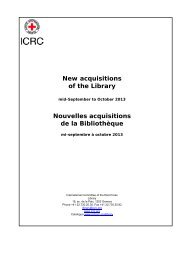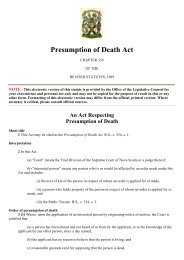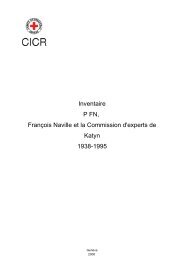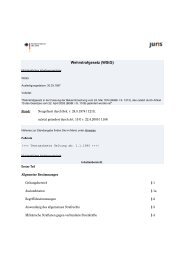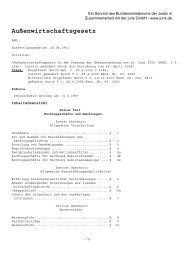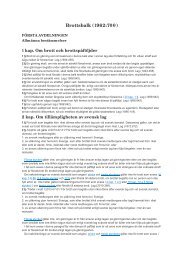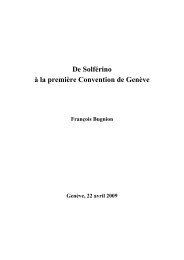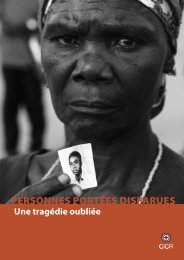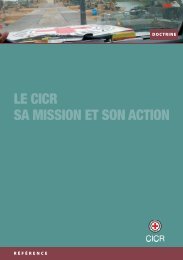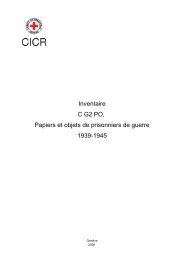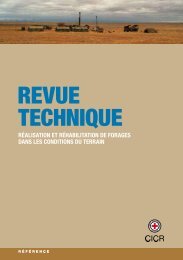Trans-Femoral Prosthesis - International Committee of the Red Cross
Trans-Femoral Prosthesis - International Committee of the Red Cross
Trans-Femoral Prosthesis - International Committee of the Red Cross
You also want an ePaper? Increase the reach of your titles
YUMPU automatically turns print PDFs into web optimized ePapers that Google loves.
Manufacturing guidelines<br />
trans-<strong>Femoral</strong> <strong>Pros<strong>the</strong>sis</strong><br />
Physical Rehabilitation Programme
<strong>International</strong> <strong>Committee</strong> <strong>of</strong> <strong>the</strong> <strong>Red</strong> <strong>Cross</strong><br />
19 Avenue de la Paix<br />
1202 Geneva, Switzerland<br />
T + 41 22 734 60 01 F + 41 22 733 20 57<br />
E-mail: icrc.gva@icrc.org<br />
www.icrc.org<br />
© ICRC, September 2006<br />
All photographs: ICRC/PRP
Table <strong>of</strong> contents<br />
Foreword 2<br />
Introduction 4<br />
1. Raw materials and components 4<br />
2. Measurements and socket manufacture 5<br />
2.1 <strong>Trans</strong>-femoral cup alignment and socket manufacture 6<br />
2.2 Total-contact pros<strong>the</strong>sis 11<br />
3. Building up <strong>the</strong> pros<strong>the</strong>sis and bench alignment 15<br />
4. Polypropylene cosmetic manufacture 28<br />
5. EVA cosmetic manufacture 38<br />
Reference list <strong>of</strong> materials 41<br />
Manufac turing Guidelines <strong>Trans</strong>-<strong>Femoral</strong> <strong>Pros<strong>the</strong>sis</strong>
Foreword<br />
The ICRC polypropylene technology<br />
Since its inception in 1979, <strong>the</strong> ICRC’s Physical Rehabilitation Programme has promoted <strong>the</strong> use<br />
<strong>of</strong> technology that is appropriate to <strong>the</strong> specific contexts in which <strong>the</strong> organization operates,<br />
i.e., countries affected by war and low-income or developing countries.<br />
The technology must also be tailored to meet <strong>the</strong> needs <strong>of</strong> <strong>the</strong> physically disabled in <strong>the</strong> countries<br />
concerned.<br />
The technology adopted must <strong>the</strong>refore be:<br />
• durable, comfortable, easy for patients to use and maintain;<br />
• easy for technicians to learn, use and repair;<br />
• standardized but compatible with <strong>the</strong> climate in different regions <strong>of</strong> <strong>the</strong> world;<br />
• low-cost but modern and consistent with internationally accepted standards;<br />
• easily available.<br />
The choice <strong>of</strong> technology is <strong>of</strong> great importance for promoting sustainable physical rehabilitation<br />
services.<br />
For all <strong>the</strong>se reasons, <strong>the</strong> ICRC preferred to develop its own technique instead <strong>of</strong> buying ready-made<br />
orthopaedic components, which are generally too expensive and unsuited to <strong>the</strong> contexts in which<br />
<strong>the</strong> organization works. The cost <strong>of</strong> <strong>the</strong> materials used in ICRC pros<strong>the</strong>tic and orthotic devices<br />
is lower than that <strong>of</strong> <strong>the</strong> materials used in appliances assembled from commercial ready-made<br />
components.<br />
When <strong>the</strong> ICRC launched its physical rehabilitation programmes back in 1979, locally available<br />
materials such as wood, lea<strong>the</strong>r and metal were used, and orthopaedic components were<br />
manufactured locally. In <strong>the</strong> early 1990s <strong>the</strong> ICRC started <strong>the</strong> process <strong>of</strong> standardizing <strong>the</strong><br />
techniques used in its various projects around <strong>the</strong> world, for <strong>the</strong> sake <strong>of</strong> harmonization between <strong>the</strong><br />
projects, but more importantly to improve <strong>the</strong> quality <strong>of</strong> services to patients.<br />
Polypropylene (PP) was introduced into ICRC projects in 1988 for <strong>the</strong> manufacture <strong>of</strong> pros<strong>the</strong>tic<br />
sockets. The first polypropylene knee-joint was produced in Cambodia in 1991; o<strong>the</strong>r components<br />
such as various alignment systems were first developed in Colombia and gradually improved. In<br />
parallel, a durable foot, made initially <strong>of</strong> polypropylene and EthylVinylAcetate (EVA), and now <strong>of</strong><br />
polypropylene and polyurethane, replaced <strong>the</strong> traditional wooden/rubber foot.<br />
In 1998, after careful consideration, it was decided to scale down local component production in<br />
order to focus on patient care and training <strong>of</strong> personnel at country level.<br />
ICRC Physical Rehabilitation Programme
Objective <strong>of</strong> <strong>the</strong> manuals<br />
The ICRC’s “Manufacturing Guidelines” are designed to provide <strong>the</strong> information necessary for<br />
production <strong>of</strong> high-quality assistive devices.<br />
The main aims <strong>of</strong> <strong>the</strong>se informative manuals are as follows:<br />
• To promote and enhance standardization <strong>of</strong> ICRC polypropylene technology;<br />
• To provide support for training in <strong>the</strong> use <strong>of</strong> this technology;<br />
• To promote good practice.<br />
This is ano<strong>the</strong>r step forward in <strong>the</strong> effort to ensure that patients have access to high-quality services.<br />
ICRC<br />
Assistance Division/Health Unit<br />
Physical Rehabilitation Programme<br />
Manufac turing Guidelines <strong>Trans</strong>-<strong>Femoral</strong> <strong>Pros<strong>the</strong>sis</strong>
Introduction<br />
The aim <strong>of</strong> this document is to describe a method for manufacturing trans-femoral (TF) pros<strong>the</strong>ses<br />
using <strong>the</strong> ICRC’s polypropylene technology as applied at <strong>the</strong> Physical Rehabilitation Centre in<br />
Addis Ababa.<br />
The casting, rectification and alignment methods used correspond to international pros<strong>the</strong>tic and<br />
orthotic (P&O) standards <strong>of</strong> practice and are <strong>the</strong>refore not described in <strong>the</strong>se ICRC manufacturing<br />
guidelines.<br />
1<br />
Raw maTeRIals and COmpOnenTs<br />
<strong>Trans</strong>-femoral kits are available in adult and child sizes.<br />
6Contents <strong>of</strong> <strong>the</strong> kit:<br />
Solid Ankle Cushion Heel (SACH) foot<br />
Hexagonal-head bolt and lock washer<br />
Convex ankle<br />
Concave cylinder and pin<br />
5 Set <strong>of</strong> washers, nut and bolt<br />
6 Convex disc<br />
7 Conical cup<br />
8 <strong>Trans</strong>-femoral cup<br />
9 Knee shell<br />
ICRC Physical Rehabilitation Programme
2<br />
measuRemenTs and sOCkeT manuFaCTuRe<br />
assessment, measurements and casting<br />
4The patient is assessed, a prescription is<br />
made and measurements are taken in<br />
accordance with best P&O practice.<br />
4A negative cast is taken in accordance<br />
with usual P&O practice.<br />
Manufac turing Guidelines <strong>Trans</strong>-<strong>Femoral</strong> <strong>Pros<strong>the</strong>sis</strong><br />
5
6<br />
4The mould is filled to produce<br />
<strong>the</strong> positive, which is rectified<br />
according to <strong>the</strong> measurements<br />
taken.<br />
2.1 <strong>Trans</strong>-femoral cup alignment and socket manufacture<br />
4Chamfer <strong>the</strong> edge <strong>of</strong> <strong>the</strong><br />
trans-femoral cup.<br />
ICRC Physical Rehabilitation Programme
alignment <strong>of</strong> <strong>the</strong> trans-femoral cup<br />
4Cover <strong>the</strong> mould with nylon.<br />
Fix <strong>the</strong> nail at <strong>the</strong> bottom <strong>of</strong> <strong>the</strong><br />
mould, where <strong>the</strong> cup will be attached.<br />
Place <strong>the</strong> TF mould on <strong>the</strong> CR<br />
alignment jig; align according to<br />
<strong>the</strong> instructions on <strong>the</strong> use <strong>of</strong> <strong>the</strong><br />
jig (separate manual). Make <strong>the</strong><br />
alignment in accordance with <strong>the</strong><br />
measurement card. Fix <strong>the</strong> cup to <strong>the</strong><br />
socket with plaster <strong>of</strong> Paris (POP).<br />
4Add a piece <strong>of</strong> EVA at <strong>the</strong> distal part <strong>of</strong><br />
<strong>the</strong> cup.<br />
This will prevent <strong>the</strong> PP from being<br />
drawn in during suction.<br />
It will also facilitate opening.<br />
Manufac turing Guidelines <strong>Trans</strong>-<strong>Femoral</strong> <strong>Pros<strong>the</strong>sis</strong><br />
7
8<br />
4Cut a sheet <strong>of</strong> 5 mm PP according to<br />
<strong>the</strong> measurements (add 5 cm to <strong>the</strong><br />
circumference and 10-15 cm to <strong>the</strong><br />
length).<br />
Leave <strong>the</strong> PP in <strong>the</strong> oven at around<br />
180° for about 20 minutes.<br />
Drape <strong>the</strong> PP on <strong>the</strong> mould and<br />
open <strong>the</strong> vacuum suction.<br />
4Cut <strong>of</strong>f <strong>the</strong> excess PP.<br />
Leave <strong>the</strong> vacuum on until <strong>the</strong> PP<br />
cools down.<br />
4Wait at least 6 hours before opening.<br />
Draw <strong>the</strong> trim line on <strong>the</strong> proximal<br />
part <strong>of</strong> <strong>the</strong> socket.<br />
Use <strong>the</strong> oscillating saw to cut <strong>the</strong> PP.<br />
Remove <strong>the</strong> plaster.<br />
ICRC Physical Rehabilitation Programme
4Grind <strong>the</strong> distal part <strong>of</strong> <strong>the</strong> cup down to<br />
<strong>the</strong> EVA pad.<br />
Use a screwdriver to remove <strong>the</strong> EVA.<br />
4Grind <strong>the</strong> distal part until it is flat.<br />
4Grind <strong>the</strong> distal part until it is flat.<br />
Do not remove all <strong>the</strong> PP.<br />
4Check that <strong>the</strong> surface is flat.<br />
Manufac turing Guidelines <strong>Trans</strong>-<strong>Femoral</strong> <strong>Pros<strong>the</strong>sis</strong><br />
9
4Grind <strong>the</strong> socket along <strong>the</strong> trim lines<br />
with <strong>the</strong> router.<br />
4Use a sharp piece <strong>of</strong> glass to smooth <strong>the</strong><br />
edge <strong>of</strong> <strong>the</strong> socket.<br />
4Using a conical drill, make <strong>the</strong> hole for<br />
<strong>the</strong> cotton stocking or for <strong>the</strong> suction<br />
valve.<br />
0 ICRC Physical Rehabilitation Programme
2.2 Total-contact pros<strong>the</strong>sis<br />
There are two ways <strong>of</strong> manufacturing a total-contact trans-femoral socket:<br />
1. By <strong>the</strong> same procedure as for a conventional TF;<br />
2. By welding <strong>the</strong> conical cup directly under <strong>the</strong> PP socket.<br />
6Position <strong>the</strong> suction valve medio-laterally and distally to <strong>the</strong> plaster mould.<br />
Use <strong>the</strong> suction valve ring to shape <strong>the</strong> plaster. <strong>Red</strong>uce <strong>the</strong> diameter <strong>of</strong> <strong>the</strong><br />
plaster to allow for <strong>the</strong> thickness <strong>of</strong> PP used (4 or 5 mm). Smooth it nicely<br />
and break <strong>the</strong> edge. (see 2.1, page 6).<br />
4Cover <strong>the</strong> mould with a nylon<br />
stocking.<br />
Fix <strong>the</strong> cup with plaster in <strong>the</strong><br />
usual way.<br />
Manufac turing Guidelines <strong>Trans</strong>-<strong>Femoral</strong> <strong>Pros<strong>the</strong>sis</strong>
During <strong>the</strong> first fitting, glue a piece <strong>of</strong> EVA inside <strong>the</strong> cup in order to avoid air leakage.<br />
Glue a 12 mm and a 6 mm piece <strong>of</strong> EVA inside <strong>the</strong> cup. Finally, use a 3 mm piece to cover <strong>the</strong> cup<br />
and <strong>the</strong> sides <strong>of</strong> <strong>the</strong> cup.<br />
6Material needed for finishing.<br />
6 mm<br />
6Glue <strong>the</strong> 12 mm and 6 mm EVA discs inside <strong>the</strong> cup.<br />
6Lastly, glue <strong>the</strong> 3 mm EVA all around <strong>the</strong> cup.<br />
ICRC Physical Rehabilitation Programme<br />
12 mm<br />
3 mm<br />
3 mm
4Drill a hole according to <strong>the</strong> diameter<br />
<strong>of</strong> <strong>the</strong> suction valve.<br />
4Smooth <strong>the</strong> edge with a sharp piece<br />
<strong>of</strong> glass.<br />
4Test <strong>the</strong> suction valve and check by<br />
adding water inside <strong>the</strong> socket.<br />
Manufac turing Guidelines <strong>Trans</strong>-<strong>Femoral</strong> <strong>Pros<strong>the</strong>sis</strong>
4If <strong>the</strong> conical cup is used, it must be<br />
adjusted to <strong>the</strong> socket in accordance with<br />
<strong>the</strong> alignment.<br />
Use <strong>the</strong> welding iron to make a groove<br />
between <strong>the</strong> socket and <strong>the</strong> conical cup.<br />
4Use <strong>the</strong> hot-air welding gun to weld <strong>the</strong><br />
cup to <strong>the</strong> socket.<br />
This has to be done very carefully to<br />
avoid breakage during <strong>the</strong> first fitting.<br />
ICRC Physical Rehabilitation Programme
3<br />
BuIldIng up The pROsThesIs and BenCh alIgnmenT<br />
The building-up and bench alignment process – steps to follow<br />
• Ankle-foot alignment<br />
• Socket alignment<br />
• Adjustment <strong>of</strong> length<br />
• Welding <strong>of</strong> cylinders<br />
• Alignment <strong>of</strong> finished pros<strong>the</strong>sis<br />
ankle-foot alignment<br />
An extra 4 mm plate must be attached to <strong>the</strong> convex ankle. (For 6 mm ankle disc only.)<br />
Drill two holes as shown on <strong>the</strong> illustration below and fix <strong>the</strong> two components toge<strong>the</strong>r with a PP<br />
welding rod. (For 6 mm ankle disc only.)<br />
This will prevent breakage <strong>of</strong> <strong>the</strong> foot bolt.<br />
6Components for 6 mm ankle disc only.<br />
6Preparation before fixation for 6 mm ankle disc only.<br />
Manufac turing Guidelines <strong>Trans</strong>-<strong>Femoral</strong> <strong>Pros<strong>the</strong>sis</strong><br />
5
6<br />
6Fixation procedure.<br />
6Final result for 6 mm ankle disc only.<br />
ICRC Physical Rehabilitation Programme<br />
6For maximum strength <strong>of</strong> <strong>the</strong><br />
assembly, <strong>the</strong> opening <strong>of</strong> <strong>the</strong> concave<br />
cylinder must be in front, and <strong>the</strong><br />
reinforcement bar at <strong>the</strong> back.
The ankle alignment system allows dorsal and plantar flexion, medio-lateral movements so that <strong>the</strong><br />
pros<strong>the</strong>sis can be adjusted to <strong>the</strong> heel height <strong>of</strong> <strong>the</strong> shoe.<br />
The alignment can be adjusted for a heel height <strong>of</strong> between 0 mm and 20 mm, but a heel height <strong>of</strong><br />
10 mm is recommended.<br />
The heel height is adjusted according to <strong>the</strong> patient’s shoe; <strong>the</strong> concave cylinder must be<br />
perpendicular to <strong>the</strong> ground.<br />
4The foot is adjusted in<br />
external rotations <strong>of</strong> 5°.<br />
4Check <strong>the</strong> alignment once<br />
again with <strong>the</strong> patient’s<br />
shoe on <strong>the</strong> foot.<br />
Manufac turing Guidelines <strong>Trans</strong>-<strong>Femoral</strong> <strong>Pros<strong>the</strong>sis</strong><br />
7
8<br />
knee-ankle-foot alignment<br />
6Same measurement.<br />
4The measurement taken on <strong>the</strong> patient must be<br />
from <strong>the</strong> medial tibial plateau plus 1.5 to 2 cm<br />
to <strong>the</strong> ground.<br />
4<strong>Trans</strong>fer this measurement from <strong>the</strong> foot up to<br />
<strong>the</strong> mechanical knee-joint axis.<br />
ICRC Physical Rehabilitation Programme
4Draw a line with a marker according to<br />
<strong>the</strong> measurement taken.<br />
Make ano<strong>the</strong>r mark 9 cm from <strong>the</strong> first.<br />
This corresponds to <strong>the</strong> bottom <strong>of</strong> <strong>the</strong><br />
concave cylinder minus 1 cm.<br />
4Use <strong>the</strong> pipe cutter to make <strong>the</strong> cut.<br />
Smooth <strong>the</strong> edges.<br />
4Pay special attention to <strong>the</strong> rotation <strong>of</strong><br />
<strong>the</strong> knee-joint with <strong>the</strong> foot.<br />
Heat <strong>the</strong> distal part <strong>of</strong> <strong>the</strong> pipe with <strong>the</strong><br />
hot-air welding gun.<br />
Use a rubber mallet to insert <strong>the</strong><br />
knee-joint into <strong>the</strong> concave cylinder as<br />
far as <strong>the</strong> mark.<br />
Manufac turing Guidelines <strong>Trans</strong>-<strong>Femoral</strong> <strong>Pros<strong>the</strong>sis</strong><br />
9
socket and bench alignment<br />
length adjustment for normal stump length<br />
The socket is connected to <strong>the</strong> conical cup (after length adjustment) with a convex disc in between.<br />
The conical cup is welded directly on top <strong>of</strong> <strong>the</strong> knee joint. The convex disc allows abduction,<br />
adduction, flexion, extension and shifting in all directions.<br />
6Check <strong>the</strong> alignment and adjust <strong>the</strong> conical cup according to <strong>the</strong> measurements taken.<br />
Cup opening in front<br />
CORReCT<br />
0 ICRC Physical Rehabilitation Programme<br />
Cup opening at back<br />
InCORReCT
6The force patterns on heel strike are as shown in <strong>the</strong>se illustrations.<br />
Breakages can happen easily.<br />
6Make sure <strong>the</strong> conical cup remains horizontal in both planes before welding it.<br />
Check also knee alignment and foot rotation.<br />
Manufac turing Guidelines <strong>Trans</strong>-<strong>Femoral</strong> <strong>Pros<strong>the</strong>sis</strong>
welding <strong>the</strong> cylinders<br />
4The temperature <strong>of</strong> <strong>the</strong> mirror should<br />
be between 185° and 200° C.<br />
4Hold <strong>the</strong> cylinder on <strong>the</strong> mirror welder<br />
for no more than 5 minutes until a roll<br />
<strong>of</strong> melted PP is formed.<br />
Weld according to <strong>the</strong> marks and apply<br />
slight pressure.<br />
ICRC Physical Rehabilitation Programme
length adjustment for a short stump<br />
1. The socket is connected to <strong>the</strong> conical cup with a convex disc in between.<br />
2. The second conical cup is connected to <strong>the</strong> knee-joint with ano<strong>the</strong>r convex disc in between.<br />
3. Once <strong>the</strong> height has been adjusted, <strong>the</strong> conical cups can be welded toge<strong>the</strong>r.<br />
Static or dynamic alignment can be done ei<strong>the</strong>r above <strong>the</strong> knee-joint or below <strong>the</strong> socket.<br />
length adjustment for a long stump: pay attention to minimum dimensions (see below)<br />
A 22 mm for convex/concave plates<br />
B 40 mm minimum distance between connection surface and axis <strong>of</strong> <strong>the</strong> knee<br />
Dimensions to be determined:<br />
A device for adjusting<br />
alignment<br />
B distance between upper<br />
part <strong>of</strong> <strong>the</strong> knee-joint and<br />
knee axis<br />
A B<br />
A = 22 mm (minimum)<br />
B = 40 mm<br />
Manufac turing Guidelines <strong>Trans</strong>-<strong>Femoral</strong> <strong>Pros<strong>the</strong>sis</strong>
ICRC Physical Rehabilitation Programme
Manufac turing Guidelines <strong>Trans</strong>-<strong>Femoral</strong> <strong>Pros<strong>the</strong>sis</strong><br />
5
6<br />
Final pros<strong>the</strong>sis alignment<br />
6Modular PP technology allows sliding and tilting during alignment.<br />
neutral position Flexion extension<br />
med. laT. anT. posT. anT. posT.<br />
6Backward or anterior shifting is possible. Shifting can also occur medially or laterally.<br />
anT. posT. anT. posT. med. laT.<br />
ICRC Physical Rehabilitation Programme
Belt manufacture<br />
During <strong>the</strong> first fitting with <strong>the</strong> patient, <strong>the</strong> measurement for <strong>the</strong> belt is taken from <strong>the</strong> great<br />
trochanter, around <strong>the</strong> waist and above <strong>the</strong> opposite iliac crest as far as Scarpa’s triangle.<br />
The belt can be ei<strong>the</strong>r a lea<strong>the</strong>r or a cotton strap, fixed with a 16 mm buckle.<br />
Add 15 cm to <strong>the</strong> measurement taken on <strong>the</strong> patient to allow for adjustment during fitting.<br />
Manufac turing Guidelines <strong>Trans</strong>-<strong>Femoral</strong> <strong>Pros<strong>the</strong>sis</strong><br />
7
4<br />
pOlypROpylene COsmeTIC manuFaCTuRe<br />
6All components have to be welded toge<strong>the</strong>r.<br />
6Drill a 5 mm hole in <strong>the</strong> concave cylinder and<br />
<strong>the</strong> pipe.<br />
8 ICRC Physical Rehabilitation Programme<br />
6Fix <strong>the</strong> expansion pin.
4Remove <strong>the</strong> excess PP for finishing at<br />
<strong>the</strong> ankle plate.<br />
4Draw a line following <strong>the</strong> shape <strong>of</strong><br />
<strong>the</strong> foot.<br />
4Disassemble <strong>the</strong> foot.<br />
Manufac turing Guidelines <strong>Trans</strong>-<strong>Femoral</strong> <strong>Pros<strong>the</strong>sis</strong><br />
9
0<br />
6Check your mark and grind it carefuly. Check once more against <strong>the</strong> foot.<br />
4Stick adhesive tape on <strong>the</strong> foot and make<br />
a mark with a permanent marker on <strong>the</strong><br />
top <strong>of</strong> <strong>the</strong> convex ankle and on <strong>the</strong> tape.<br />
4Remove <strong>the</strong> foot and draw a line all<br />
around <strong>the</strong> plate 4 mm from <strong>the</strong> edge.<br />
Grind <strong>the</strong> edge carefully.<br />
ICRC Physical Rehabilitation Programme<br />
Minus<br />
mm
4Check again with <strong>the</strong> foot.<br />
Once a good fit has been achieved, weld<br />
<strong>the</strong> two plates toge<strong>the</strong>r: first make a<br />
groove with <strong>the</strong> welding iron and <strong>the</strong>n<br />
weld with <strong>the</strong> hot-air welding gun.<br />
Grind again to obtain a smooth finish.<br />
6For heavy and active patients, a strip <strong>of</strong> 3 mm PP can be draped around <strong>the</strong> conical cup and<br />
alignment system for extra strength. Use an elastic bandage to tighten it well.<br />
Manufac turing Guidelines <strong>Trans</strong>-<strong>Femoral</strong> <strong>Pros<strong>the</strong>sis</strong>
4When <strong>the</strong> PP has cooled down, grind<br />
<strong>the</strong> edges and weld.<br />
4Protect <strong>the</strong> knee-joint with adhesive<br />
tape.<br />
Grind <strong>the</strong> socket with sandpaper to<br />
roughen it.<br />
Fill <strong>the</strong> socket with POP in order to fix<br />
<strong>the</strong> pipe.<br />
ICRC Physical Rehabilitation Programme
4Shape <strong>the</strong> socket with plaster<br />
according to <strong>the</strong> measurement.<br />
4Smooth <strong>the</strong> plaster and cover it<br />
with a stocking.<br />
4Drape 4 mm PP around <strong>the</strong><br />
socket in <strong>the</strong> same way as for <strong>the</strong><br />
first socket.<br />
Manufac turing Guidelines <strong>Trans</strong>-<strong>Femoral</strong> <strong>Pros<strong>the</strong>sis</strong>
6Once <strong>the</strong> PP has cooled down, remove <strong>the</strong> proximal part.<br />
Use <strong>the</strong> oscillating saw to open <strong>the</strong> seam.<br />
Remove <strong>the</strong> plaster and clean up <strong>the</strong> socket.<br />
Trim <strong>the</strong> shell proximally and distally in line with <strong>the</strong> socket and <strong>the</strong> knee-joint.<br />
Replace <strong>the</strong> shell on <strong>the</strong> socket.<br />
Weld <strong>the</strong> seam.<br />
Weld <strong>the</strong> proximal edge.<br />
Weld <strong>the</strong> shell to <strong>the</strong> knee-joint.<br />
ICRC Physical Rehabilitation Programme
4When <strong>the</strong> welding is completed,<br />
remove <strong>the</strong> excess PP.<br />
• Grind <strong>the</strong> seam between <strong>the</strong><br />
shell and <strong>the</strong> knee-joint.<br />
• The seam must be ground<br />
almost flush with <strong>the</strong> socket.<br />
• Grind <strong>the</strong> proximal edge <strong>of</strong> <strong>the</strong><br />
socket.<br />
These three parts must <strong>the</strong>n be<br />
polished.<br />
4Protect <strong>the</strong> pipe and <strong>the</strong> knee-joint<br />
with tape.<br />
4Shape <strong>the</strong> shank with POP and<br />
drape a sheet <strong>of</strong> 4 mm PP over it.<br />
Manufac turing Guidelines <strong>Trans</strong>-<strong>Femoral</strong> <strong>Pros<strong>the</strong>sis</strong><br />
5
4Open <strong>the</strong> shell and remove <strong>the</strong><br />
plaster.<br />
4Insert <strong>the</strong> pros<strong>the</strong>sis into <strong>the</strong><br />
cosmetic shell.<br />
Determine and grind <strong>the</strong><br />
proximal trim line for maximum<br />
flexion <strong>of</strong> <strong>the</strong> knee-joint.<br />
4Weld <strong>the</strong> seam and <strong>the</strong> ankle<br />
connection.<br />
6 ICRC Physical Rehabilitation Programme
4Grind and smooth <strong>the</strong> welding.<br />
6Insert an EVA washer cut to <strong>the</strong> same shape as <strong>the</strong> shank about 10 cm below <strong>the</strong><br />
knee-joint to keep <strong>the</strong> cosmetic shank in place. This will also prevent creaking.<br />
4Fix <strong>the</strong> knee-joint back onto <strong>the</strong> shank.<br />
Fix <strong>the</strong> belt.<br />
Manufac turing Guidelines <strong>Trans</strong>-<strong>Femoral</strong> <strong>Pros<strong>the</strong>sis</strong><br />
7
5<br />
eVa COsmeTIC manuFaCTuRe<br />
6Roughen <strong>the</strong> EVA before applying it to <strong>the</strong> PP socket. Glue layers <strong>of</strong> EVA on <strong>the</strong> socket and shape it.<br />
A final layer <strong>of</strong> 3 mm EVA will cover <strong>the</strong> entire pros<strong>the</strong>sis, increasing <strong>the</strong> circumference by 1 cm.<br />
4Cut a sheet <strong>of</strong> 12 mm EVA<br />
corresponding to <strong>the</strong> circumference<br />
<strong>of</strong> <strong>the</strong> wooden or plaster model<br />
shank. Skive both sides <strong>of</strong> <strong>the</strong> EVA<br />
and glue.<br />
8 ICRC Physical Rehabilitation Programme
4Place <strong>the</strong> sheet <strong>of</strong> EVA in <strong>the</strong> oven<br />
at about 120° until it becomes s<strong>of</strong>t,<br />
<strong>the</strong>n bend it to obtain a conical<br />
shape. Add talcum powder inside<br />
<strong>the</strong> cone and put it back in <strong>the</strong> oven.<br />
4Pull <strong>the</strong> EVA cone over <strong>the</strong> model<br />
shank and tighten it with an elastic<br />
bandage, or use a vacuum system.<br />
4Cut <strong>the</strong> posterior proximal edge to<br />
allow flexion <strong>of</strong> <strong>the</strong> knee-joint.<br />
Manufac turing Guidelines <strong>Trans</strong>-<strong>Femoral</strong> <strong>Pros<strong>the</strong>sis</strong><br />
9
4Tip: for finishing purposes, wind a tape<br />
around <strong>the</strong> proximal aspect <strong>of</strong> <strong>the</strong> foot<br />
to prevent damage to <strong>the</strong> foot cosmetic<br />
during grinding <strong>of</strong> <strong>the</strong> EVA.<br />
4Shape <strong>the</strong> shank according to <strong>the</strong><br />
measurements taken on <strong>the</strong> sound leg.<br />
Then glue it distally on top <strong>of</strong> <strong>the</strong> foot.<br />
Insert an EVA washer cut to <strong>the</strong> shape<br />
<strong>of</strong> <strong>the</strong> shank about 10 cm below <strong>the</strong><br />
knee-joint to keep <strong>the</strong> cosmetic shank<br />
in place.<br />
Fix <strong>the</strong> shank to <strong>the</strong> socket. Fix <strong>the</strong> belt.<br />
0 ICRC Physical Rehabilitation Programme
Reference list <strong>of</strong> materials<br />
Manufac turing Guidelines <strong>Trans</strong>-<strong>Femoral</strong> <strong>Pros<strong>the</strong>sis</strong>
ICRC Physical Rehabilitation Programme
Manufac turing Guidelines <strong>Trans</strong>-<strong>Femoral</strong> <strong>Pros<strong>the</strong>sis</strong>
ICRC Physical Rehabilitation Programme
Manufac turing Guidelines <strong>Trans</strong>-<strong>Femoral</strong> <strong>Pros<strong>the</strong>sis</strong><br />
5
6 ICRC Physical Rehabilitation Programme
pp, eVa and o<strong>the</strong>r consumables<br />
Designation Used for<br />
Materials<br />
POP bandage 15 cm Cast-taking<br />
POP powder Positive mould<br />
Contact glue S<strong>of</strong>t socket<br />
Soap (demoulding agent) Positive mould<br />
Talcum powder Therm<strong>of</strong>orming<br />
Vaseline Cast-taking<br />
Nails Positive mould<br />
Colorant for plaster Positive mould<br />
Cotton/nylon stockinet dia. 8 or 10 cm Cast-taking<br />
Cotton stockinet or sock Stump sock<br />
PP welding rod dia. 4 mm Welding components<br />
Polypropylene 5 mm Hard socket<br />
Polypropylene cosmetic<br />
Polypropylene 4 mm Cosmetic shell<br />
PP welding rod dia. 4 mm Welding components<br />
POP powder Cosmetic shape<br />
Adhesive tape<br />
EVA cosmetic<br />
EVA 3 mm; 6 mm; 12 mm<br />
Contact glue<br />
Manufac turing Guidelines <strong>Trans</strong>-<strong>Femoral</strong> <strong>Pros<strong>the</strong>sis</strong><br />
7
MISSION<br />
The <strong>International</strong> <strong>Committee</strong> <strong>of</strong> <strong>the</strong> <strong>Red</strong> <strong>Cross</strong> (ICRC) is an impartial, neutral and<br />
independent organization whose exclusively humanitarian mission is to protect <strong>the</strong><br />
lives and dignity <strong>of</strong> victims <strong>of</strong> war and internal violence and to provide <strong>the</strong>m with<br />
assistance. It directs and coordinates <strong>the</strong> international relief activities conducted<br />
by <strong>the</strong> Movement in situations <strong>of</strong> conflict. It also endeavours to prevent suffering<br />
by promoting and streng<strong>the</strong>ning humanitarian law and universal humanitarian<br />
principles. Established in 1863, <strong>the</strong> ICRC is at <strong>the</strong> origin <strong>of</strong> <strong>the</strong> <strong>International</strong> <strong>Red</strong><br />
<strong>Cross</strong> and <strong>Red</strong> Crescent Movement.<br />
Acknowledgements:<br />
Jean François Gallay<br />
Leo Gasser<br />
Pierre Gauthier<br />
Frank Joumier<br />
Jacques Lepetit<br />
Bernard Matagne<br />
Joel Nininger<br />
Guy Nury<br />
Peter Poetsma<br />
Hmayak Tarakhchyan<br />
and all pros<strong>the</strong>tists-orthotists who have worked in ICRC-assisted physical rehabilitation centres.
0868/002 09/2006 200



